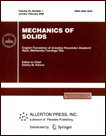 | | Mechanics of Solids
A Journal of Russian Academy of Sciences | | Founded
in January 1966
Issued 6 times a year
Print ISSN 0025-6544
Online ISSN 1934-7936 |
Archive of Issues
| Total articles in the database: | | 13362 |
| In Russian (Èçâ. ÐÀÍ. ÌÒÒ): | | 8178
|
| In English (Mech. Solids): | | 5184 |
|
| << Previous article | Volume 59, Issue 5 / 2024 | Next article >> |
| V.A. Babeshko, O.V. Evdokimova, S.B. Uafa, V.S. Evdokimov, and O.M. Babeshko, "On Nonstationary Contact Problems for Anisotropic Composites in Nonclassical Areas," Mech. Solids. 59 (5), 2667-2673 (2024) |
| Year |
2024 |
Volume |
59 |
Number |
5 |
Pages |
2667-2673 |
| DOI |
10.1134/S0025654424603562 |
| Title |
On Nonstationary Contact Problems for Anisotropic Composites in Nonclassical Areas |
| Author(s) |
V.A. Babeshko (Kuban State University, Krasnodar, 350040 Russia, babeshko41@mail.ru)
O.V. Evdokimova (Southern Scientific Center, Russian Academy of Sciences, Rostov-on-Don, 344006 Russia)
S.B. Uafa (Kuban State University, Krasnodar, 350040 Russia)
V.S. Evdokimov (Kuban State University, Krasnodar, 350040 Russia)
O.M. Babeshko (Kuban State University, Krasnodar, 350040 Russia) |
| Abstract |
For the first time, an exact solution is given to the contact problem of the non-stationary
action of a wedge-shaped, right-angled stamp occupying the first quadrant, which act on a deformable
multilayer base. The base, which is affected by a rigid stamp in the shape of a quarter plane, can be a
multilayer anisotropic composite material. It is assumed that it is possible to construct a Green’s function for it, which makes it possible to construct an integral equation of the contact problem. The geometric Cartesian coordinates of the first quadrant and the time parameter, which varies along the
entire axis, are taken as parameters describing the integral equation. It is assumed that time in the
boundary value problem under consideration follows from negative infinity, crosses the origin and
grows to infinity, covering the entire time interval. Thus, there is no requirement in the formulation of
the Cochet problem when it is necessary to set initial conditions. In this formulation, the problem is
reduced to solving the three-dimensional Wiener–Hopf integral equation. The authors are not aware
of any attempts to solve this problem analytically or numerically. The investigation and solution of the
contact problem was carried out using block elements in a variant applicable to integral equations. It is
proved that the constructed solution exactly satisfies the integral equation. The properties of the constructed solution are studied. In particular, it is shown that the solution of the non-stationary contact
problem has a higher concentration of contact stresses at the edges of the stamps and at the angular
point of the stamp, compared with a static case. This corresponds to the observed in practice more
effective non-stationary effect of rigid bodies on deformable media, for their destruction, compared
with static. The results may be useful in engineering practice, seismology, in assessing the impact of
incoming waves on foundations, in the areas of using Wiener–Hopf integral equations in probability
theory and statistics, and other areas. |
| Keywords |
contact problems, three-dimensional Wiener–Hopf integral equation, wedge-shaped domain, block element, anisotropy, composite, factorization |
| Received |
01 May 2024 | Revised |
13 May 2024 | Accepted |
14 May 2024 |
| Link to Fulltext |
|
| << Previous article | Volume 59, Issue 5 / 2024 | Next article >> |
|
 If you find a misprint on a webpage, please help us correct it promptly - just highlight and press Ctrl+Enter If you find a misprint on a webpage, please help us correct it promptly - just highlight and press Ctrl+Enter
|
|

 Russian
Russian  English
English